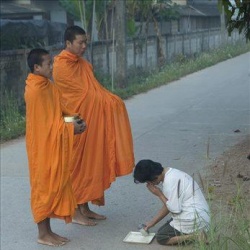Difference between revisions of "Anagarika"
(Created page with "thumb|250px| In Theravada Buddhism, an '''anagarika''' (Pali: anāgārika/ā; lit., "homeless one") is a person who has given up most or all of ...") |
|||
| (5 intermediate revisions by 2 users not shown) | |||
| Line 1: | Line 1: | ||
[[File:Alms thai.jpg|thumb|250px|]] | [[File:Alms thai.jpg|thumb|250px|]] | ||
| − | |||
| − | |||
| − | The main difference between the 8 precepts of an Anagarika and the 10 precepts of a novice | + | |
| + | |||
| + | In [[Theravada Buddhism]], an '''[[anagarika]]''' ([[Pali]]: [[anāgārika]]/ā; lit., "{{Wiki|homeless}} one") is a [[person]] who has given up most or all of his [[worldly]] {{Wiki|possessions}} and responsibilities to commit full-time to [[Buddhist practice]]. It is a midway {{Wiki|status}} between [[Bhikkhu|monk]] and [[layperson]] where one takes on the [[Eight Precepts]] for the entire [[anagarika]] period, which could be for [[Life]]. | ||
| + | |||
| + | [[Anagarikas]] usually wear white [[Clothes]] or [[robes]], depending on the [[tradition]] they follow. Some [[traditions]] have special [[ordination]] {{Wiki|ceremonies}} for [[anagarikas]], while others simply take [[the eight precepts]] with a special [[intention]]. | ||
| + | |||
| + | |||
| + | In [[monastic]] settings, lay {{Wiki|attendants}} for [[Monks]] or [[nuns]] are needed. | ||
| + | |||
| + | The [[monastic rules]] restrict [[Monks]] and [[nuns]] from many tasks that might be needed, [[including]] the use of [[money]], driving, cooking, digging and cutting [[plants]], so lay {{Wiki|attendants}} help bridge this gap. | ||
| + | |||
| + | [[Anagarikas]] differ from laity by their commitment to [[Buddhism]], to their [[precepts]] and to the [[monastics]]. | ||
| + | |||
| + | There is usually a notable difference in their [[manner]], [[appearance]] and attire. In most cases, they are full-time residents at the [[Monastery]] where they [[ordained]]. | ||
| + | |||
| + | [[Anagarikas]] often have the [[intention]] of becoming a [[Monk]] or [[nun]] at a later point, though not always. | ||
| + | |||
| + | In some [[Monasteries]] a period as an [[anagarika]], often one year, is required in [[order]] to take [[novice]] [[ordination]]. | ||
| + | |||
| + | The main difference between the 8 [[precepts]] of an [[Anagarika]] and the [[10 precepts]] of a [[novice]] [[Monk]] is the {{Wiki|rule}} of not handling [[money]]. Therefore, [[anagarika]] [[ordinations]] usually take place in {{Wiki|forest}} [[Monasteries]] where the [[monastic rules]], [[including]] the one on not handling [[money]], are strictly followed. | ||
{{W}} | {{W}} | ||
[[Category:Buddhist Terms]] | [[Category:Buddhist Terms]] | ||
| − | [[Category:Titles]] | + | |
| + | [[Category:Buddhist Titles]] | ||
Latest revision as of 08:23, 22 December 2023
In Theravada Buddhism, an anagarika (Pali: anāgārika/ā; lit., "homeless one") is a person who has given up most or all of his worldly possessions and responsibilities to commit full-time to Buddhist practice. It is a midway status between monk and layperson where one takes on the Eight Precepts for the entire anagarika period, which could be for Life.
Anagarikas usually wear white Clothes or robes, depending on the tradition they follow. Some traditions have special ordination ceremonies for anagarikas, while others simply take the eight precepts with a special intention.
In monastic settings, lay attendants for Monks or nuns are needed.
The monastic rules restrict Monks and nuns from many tasks that might be needed, including the use of money, driving, cooking, digging and cutting plants, so lay attendants help bridge this gap.
Anagarikas differ from laity by their commitment to Buddhism, to their precepts and to the monastics.
There is usually a notable difference in their manner, appearance and attire. In most cases, they are full-time residents at the Monastery where they ordained.
Anagarikas often have the intention of becoming a Monk or nun at a later point, though not always.
In some Monasteries a period as an anagarika, often one year, is required in order to take novice ordination.
The main difference between the 8 precepts of an Anagarika and the 10 precepts of a novice Monk is the rule of not handling money. Therefore, anagarika ordinations usually take place in forest Monasteries where the monastic rules, including the one on not handling money, are strictly followed.
